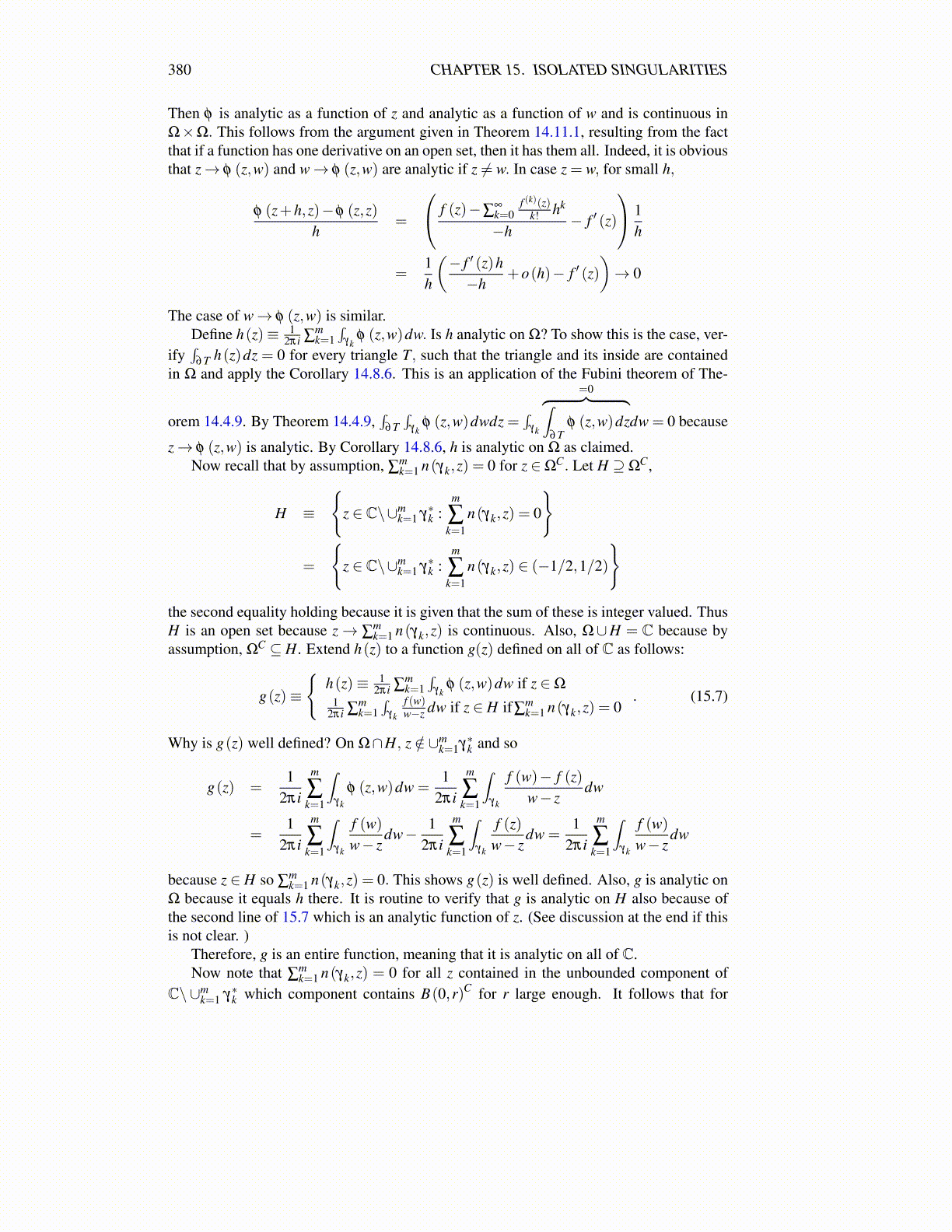
380 CHAPTER 15. ISOLATED SINGULARITIES
Then φ is analytic as a function of z and analytic as a function of w and is continuous inΩ×Ω. This follows from the argument given in Theorem 14.11.1, resulting from the factthat if a function has one derivative on an open set, then it has them all. Indeed, it is obviousthat z→ φ (z,w) and w→ φ (z,w) are analytic if z ̸= w. In case z = w, for small h,
φ (z+h,z)−φ (z,z)h
=
f (z)−∑∞k=0
f (k)(z)k! hk
−h− f ′ (z)
1h
=1h
(− f ′ (z)h−h
+o(h)− f ′ (z))→ 0
The case of w→ φ (z,w) is similar.Define h(z)≡ 1
2πi ∑mk=1
∫γk
φ (z,w)dw. Is h analytic on Ω? To show this is the case, ver-ify∫
∂T h(z)dz = 0 for every triangle T, such that the triangle and its inside are containedin Ω and apply the Corollary 14.8.6. This is an application of the Fubini theorem of The-
orem 14.4.9. By Theorem 14.4.9,∫
∂T∫
γkφ (z,w)dwdz =
∫γk
=0︷ ︸︸ ︷∫∂T
φ (z,w)dzdw = 0 because
z→ φ (z,w) is analytic. By Corollary 14.8.6, h is analytic on Ω as claimed.Now recall that by assumption, ∑
mk=1 n(γk,z) = 0 for z ∈ΩC. Let H ⊇ΩC,
H ≡
{z ∈ C\∪m
k=1 γ∗k :
m
∑k=1
n(γk,z) = 0
}
=
{z ∈ C\∪m
k=1 γ∗k :
m
∑k=1
n(γk,z) ∈ (−1/2,1/2)
}
the second equality holding because it is given that the sum of these is integer valued. ThusH is an open set because z→ ∑
mk=1 n(γk,z) is continuous. Also, Ω∪H = C because by
assumption, ΩC ⊆ H. Extend h(z) to a function g(z) defined on all of C as follows:
g(z)≡
{h(z)≡ 1
2πi ∑mk=1
∫γk
φ (z,w)dw if z ∈Ω
12πi ∑
mk=1
∫γk
f (w)w−z dw if z ∈ H if∑
mk=1 n(γk,z) = 0
. (15.7)
Why is g(z) well defined? On Ω∩H, z /∈ ∪mk=1γ∗k and so
g(z) =1
2πi
m
∑k=1
∫γk
φ (z,w)dw =1
2πi
m
∑k=1
∫γk
f (w)− f (z)w− z
dw
=1
2πi
m
∑k=1
∫γk
f (w)w− z
dw− 12πi
m
∑k=1
∫γk
f (z)w− z
dw =1
2πi
m
∑k=1
∫γk
f (w)w− z
dw
because z ∈ H so ∑mk=1 n(γk,z) = 0. This shows g(z) is well defined. Also, g is analytic on
Ω because it equals h there. It is routine to verify that g is analytic on H also because ofthe second line of 15.7 which is an analytic function of z. (See discussion at the end if thisis not clear. )
Therefore, g is an entire function, meaning that it is analytic on all of C.Now note that ∑
mk=1 n(γk,z) = 0 for all z contained in the unbounded component of
C\ ∪mk=1 γ∗k which component contains B(0,r)C for r large enough. It follows that for